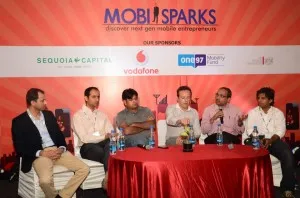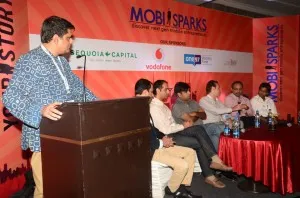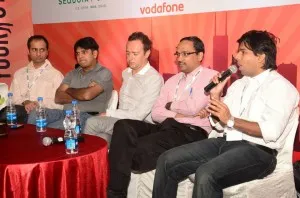MobiSparks Panellists Agree to Disagree on Mobile Opportunity in India: Some Excited, Some Cautious
Multiple Perspectives of Panellists Show Two Sides of the Coin at MobiSparks
Sanjay Anandram (moderator – Venture Partner, SeedFund); Jonathan Bill (SVP, Business Development and Innovation, Vodafone); Sandeep Amar (VP, One97); Ramesh Krishnan (User Experience, Mphasis); Ashwin Venkatraman (Head of Platforms, InMobi); Anil Mathews (Founder and CEO, Adnear); Shailesh Lakhani (Principal, Sequoia Capital).
It’s how you look at it. That famous half glass of water. That’s how panellists at MobiSparks viewed the existing situation on mobile in India. Apps are the

big drivers of this mobile “hype” but that overenthusiastic excitement about apps was toned down by Sanjay Anandram, the moderator, who said that mobile investment happened first in 2001 and now mobile has become tablet. Talk of ROIs on these investments. No big deal. In 1999, Goldman Sachs predicted India’s Internet user base would be 100 million by 2005 but only in 2011 or so did we just cross the magical figure. Now it is 137 million according to Google.Anil Mathews (the entrepreneur) said although India is a market, paid app ecosystem is not exciting and no real ad spend on mobile. India sucks as an app market? This drew the first bite of the bullet from Shailesh Lakhani (the investor) who said that Sequoia has made good investments and they are working. Sandeep Amar (the corporate executive) threw another gauntlet. The One97 VP said lack of innovation took a long time for Internet monetization. Jonathan Bill (the mobile operator) tended to agree with Sandeep and said Indians engage in too much of cut and paste and this doesn’t work as India is a unique market. Ramesh Krishnan (User Experience guy at Mphasis) provided a distraction that local problems solved in India cannot be replicated in many markets. Ashwin Venkatraman (Head of Platforms at InMobi) struck down the arguments to say that billion dollar companies like InMobi will soon happen out of India and lot of ideas are being tested. He also cautioned that design thinking is not mature in India and bandwidth, well you know, sucks.

Shailesh took the first shot at money when Sanjay (the moderator) asked where is the money in mobile and who’s making it. Shailesh said a large user base would rake in money. Sandeep said smart guys are making money through apps. And also added restrictive mobile operator is a problem. Jonathan drew an analogy. Focus on money early on and never let know you are free. Facebook proclaimed it’s free and so it got difficult to make money. Operators as controllers and distributors are calling the shots now but “changes will happen,” he predicted.The question on every app developer’s mind – Which market: India or global – was put forth to panellists by Sanjay. Ashwin realistically put it forth as it depends upon the app you are building but look at global from day one. Make the app an extension of an offline business and start that at a local level. Anil wanted the app develop to look at India first and expand that experience to outside India. Ramesh said if you make the app language-agnostic, it will become global. Language is not a barrier to sell the apps. Sandeep said going global depends on users and brings money early on. Ashwin cautioned against going to China, stating the market works very different there (need we say more?)

On enterprise mobility, Jonathan said 18 million SMEs in India is a huge opportunity. On user experience, Ashwin said the concept of design should be woven into the app and not thought of separately and added that design doesn’t mean visual appeal alone but also functionality. He was excited that in the next 18 to 24 months, Android first smart phones will flood the market and that will bring in a big opportunity. On sectoral opportunities, most panellists agreed on infotainment as the next game changer, home automation becoming possible, commerce happening, and healthcare delivered.
Jonathan said that data should be charged by the mobile operator as calls and messaging are now done through other avenues and operators are losing money there. Ramesh lamented that bandwidth is a problem and Ashwin was optimistic that video calling will happen soon.
In India, mobile continues to remain an “opportunity” but yet to become a big revenue spinner. Apps are not yet consumed in massive scale and other revenue options in mobile are not exciting either. It remains to be seen how the mobile hype will pan out. If predictions are true, the next three years will witness phenomenal changes in mobile.







